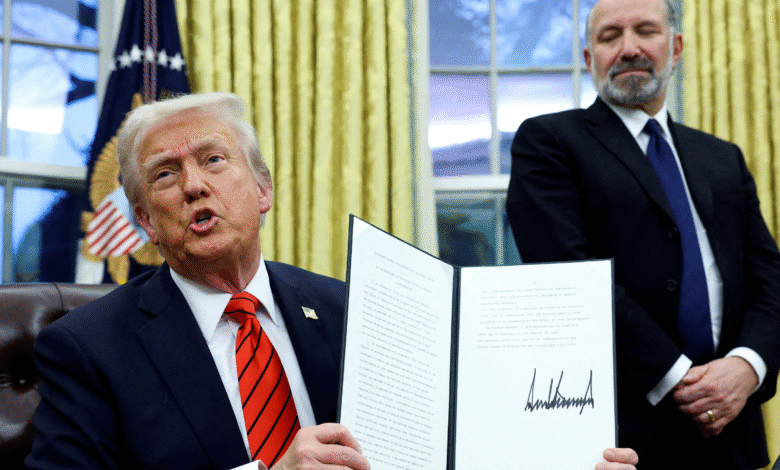Trump Tariffs Ruling: A Major Setback for Economic Agenda

In a landmark decision, a U.S. trade court has ruled that Trump exceeded his presidential powers by imposing expansive tariffs on nearly every nation, prompting a substantial shift in the economic landscape. This ruling not only halts the majority of Trump tariffs but also marks a pivotal moment in the ongoing debate over presidential authority and trade regulations. Economists from Goldman Sachs have indicated that the administration may explore alternative strategies to navigate this legal setback in their economic agenda. Attorney James Ransdell emphasized that this court decision sets a precedent for future cases addressing the limits of presidential powers regarding tariff adjustments. As the Trump administration contemplates its next steps, the ramifications of this ruling will undoubtedly reverberate through global markets and trade policies.
Recent judicial developments have shed light on the complexities surrounding tariffs imposed by the former administration. The recent ruling by the U.S. trade court has raised significant questions about the extent to which presidential powers can influence international trade regulations. Analysts, including those from Goldman Sachs, suggest that the administration may leverage various legislative avenues to adjust these trade tariffs effectively. This situation poses a critical examination of the balance between executive authority and legislative oversight in the realm of trade. As discussions continue on the implications of this ruling, the focus remains on how such decisions will impact both domestic and global economic stability.
Ruling Effects on Trump’s Economic Agenda
The recent ruling by the U.S. trade court has significant implications for President Trump’s economic agenda. It not only challenges the legitimacy of established tariffs but also highlights the constraints of presidential powers in modifying trade laws without solid legal backing. Economists and analysts note that this decision may hinder Trump’s efforts to implement further tariff adjustments, which have been a cornerstone of his approach to international trade negotiations.
As the court mandates a halt to the majority of Trump’s tariffs, the administration must navigate complex legal pathways to pursue its economic objectives. This unexpected judicial intervention could lead to delays in important trade negotiations, affecting various sectors that rely heavily on international trade. The ongoing uncertainties pose a question mark over the White House’s ability to maintain a robust economic strategy in the face of legal challenges.
Trump Tariffs Ruling: Legal Implications and Future Pathways
The Trump tariffs ruling sets a critical precedent regarding the limitations of executive power in tariff implementation. Legal experts, including Attorney James Ransdell, emphasize that this case could pave the way for further scrutiny of presidential powers surrounding trade legislation. The potential for an appeal to the Supreme Court adds another layer of complexity, indicating that the final interpretation of this ruling may be far from settled.
In response to the ruling, the Trump administration is exploring alternative legal avenues to impose tariffs, particularly utilizing Section 122 of the Trade Act of 1974. This section allows for expedited tariff adjustments without the need for lengthy investigations. Such strategies, along with other provisions from the Trade Act of 1930 like Sections 301 and 338, underscore the administration’s ongoing commitment to uphold its trade policies despite judicial setbacks.
Goldman Sachs’ Insights on Market Reactions
Goldman Sachs analysts have weighed in on the aftermath of the Trump tariffs ruling, pointing out that despite a setback, the market’s optimism is indicative of confidence in the administration’s ability to respond effectively. The analysts suggest that the White House may harness alternative methods, which could stabilize the equity markets and reassure investors. Immediate positive reactions in global stock markets illustrate a resilience to the uncertainty that typically surrounds tariff disputes.
Additionally, the slight rise of the U.S. dollar against major currencies reflects trader optimism that the Trump administration will maintain its focus on tariff strategies. Goldman Sachs prescribes that if the administration successfully identifies legal pathways to reinstate tariffs, it could not only bolster the economic agenda but also have a favorable effect on market stability moving forward.
Navigating Tariff Adjustments: A Presidential Challenge
The challenge of modifying tariffs presents a complex landscape for presidential powers. With the U.S. trade court ruling against Trump’s authority to implement sweeping tariffs, the administration is left grappling with how to navigate these unexpected obstacles. Attorneys are now calling into question the administration’s ability to make tariff adjustments swiftly, potentially leading to legislative reforms aimed at clarifying the powers of the presidency in trade matters.
Future tariff adjustments will likely depend on a mix of legal interpretations and strategic legislative maneuvers. As the Trump administration examines its options, it must carefully consider the implications each route may have on both domestic and international perceptions of U.S. trade policy, particularly given the heightened scrutiny of presidential authority.
Impact of Tariff Rulings on Global Trade Dynamics
The repercussions of the Trump tariffs ruling extend far beyond U.S. borders, influencing global trade dynamics significantly. Countries affected by the tariffs may reassess their own trade strategies, leading to a ripple effect that could change established trade relationships. As the U.S. attempts to unilaterally impose tariffs, other nations may look to leverage their positions to negotiate better terms, thereby altering the existing balance of power in international trade.
Economists stress that the persistence of such legal disputes can contribute to trade tensions that inhibit global economic growth. The outcome of the Trump tariffs ruling may incite a reevaluation of trade agreements and partnerships, prompting countries to either align with or oppose U.S. policies based on the ongoing legal discourse surrounding tariffs.
Long-Term Consequences for Presidential Powers
The long-term consequences of the Trump tariffs ruling underscore a fundamental challenge in the interpretation of presidential powers involving trade. The ruling serves as a pivotal reminder of the existing legal frameworks that restrict unilateral actions by the executive branch. As presidential powers are put to the test in this matter, future administrations may encounter similar challenges when attempting to implement aggressive trade policies.
Legal analysts believe that this ruling could lead to concerted efforts by Congress to assert its authority over trade decisions, which may reshape the balance of power in future trade-related legislation. The implications for presidential powers could reshape how trade policies are designed and enforced, potentially limiting executive actions that require negotiation with legislative branches in a changing political landscape.
Exploring Alternatives Post-Ruling
In light of the recent ruling, the Trump administration is compelled to explore alternative mechanisms for implementing tariffs. Legal pathways such as Section 122 of the Trade Act of 1974 present options for quick adjustments that bypass some of the formalities that the court ruling emphasized. However, these alternatives must be carefully evaluated to ensure they align with existing legal interpretations.
Moreover, the administration may also consider more collaborative approaches with Congress to facilitate the passage of legislation that could fortify its tariff initiatives. An emphasis on bilateral trade agreements and negotiations could serve as a viable alternative to attempting unilateral tariff imposition, potentially leading to more sustainable trade policies that garner broader support.
Investor Sentiments Amid Tariff Uncertainty
Investor sentiment plays a critical role in shaping market responses to political and legal developments. Following the Trump tariffs ruling, investors expressed cautious optimism, as reflected in the uptick in global stock markets. The ability of the administration to navigate this immediate hurdle will be closely scrutinized, driving market behavior as traders respond to the evolving narrative of U.S. trade policy.
Positive market reactions suggest that investors are hopeful for a resolution that would stabilize tariffs while boosting the economy. Nonetheless, the ongoing legal battles have instilled a sense of caution, prompting traders to remain vigilant about how future decisions by the U.S. trade court and administration may impact market conditions and trade fields.
Future of U.S. Trade Relations Post-Tariff Ruling
The trajectory of U.S. trade relations is poised for significant transformation following the Trump tariffs ruling. As the administration grapples with the court’s prohibitions on tariffs, countries like Canada, Mexico, and China are keenly observing the developments, which could shape their diplomatic and trade strategies moving forward. The potential for reevaluation of trade agreements is likely as nations adjust to the changing dynamics set forth by U.S. trade policy.
In response to the ruling, the U.S. may seek to strengthen partnerships with allies to foster a unified approach to global trade challenges. This reassessment could lead to collaborative efforts aimed at resolving existing trade disputes while establishing a more predictable trade environment. The implications for both U.S. businesses and its trading partners will depend largely on how quickly and effectively the administration adapts to these legal constraints.
Frequently Asked Questions
What was the ruling of the U.S. trade court regarding Trump tariffs ruling?
The U.S. trade court ruled that Trump exceeded his authority by using an emergency law to impose extensive tariffs on nearly all nations. This ruling mandated a permanent cessation of most tariffs and prohibits future modifications.
How does the Trump tariffs ruling affect the economic agenda of the administration?
The Trump tariffs ruling represents a significant setback to his economic agenda as it undermines the administration’s ability to enforce tariffs freely. The ruling could limit the administration’s leverage in international trade negotiations.
What are the alternative strategies mentioned by Goldman Sachs after the Trump tariffs ruling?
Goldman Sachs analysts indicated that following the Trump tariffs ruling, the administration might explore alternative legal pathways for imposing tariffs, such as using Section 122 of the Trade Act of 1974, which allows quick tariff adjustments, or considering Sections 301 and 338 of the Trade Act of 1930.
What potential implications does the Trump tariffs ruling have on presidential powers?
The ruling poses a significant challenge to presidential powers regarding the imposition of tariffs, as Attorney James Ransdell highlighted that it is one of many ongoing cases that could redefine the extent of presidential authority in trade matters.
What is the expectation for the Trump administration following the U.S. trade court’s decision?
Following the U.S. trade court’s decision against the Trump tariffs ruling, the administration is expected to appeal the ruling and explore alternative methods for imposing tariffs to maintain some level of economic control.
How did the market react to the Trump tariffs ruling?
The equity markets responded positively to the Trump tariffs ruling, with global stocks rising and the U.S. dollar showing a slight increase against major currencies, as traders remain optimistic about the administration finding ways to uphold tariffs.
Could the appeal of the Trump tariffs ruling escalate to the Supreme Court?
Yes, as noted by Attorney James Ransdell, due to the lack of precedent set by similar cases, the appeal regarding the Trump tariffs ruling could potentially escalate to the Supreme Court.
| Key Points | Details |
|---|---|
| Court Ruling | A U.S. trade court ruled Trump exceeded his authority in imposing tariffs. |
| Tariff Cessation | The Court mandated a permanent halt to most of Trump’s tariffs. |
| Appeal Process | The Trump administration has appealed this ruling. |
| Alternative Strategies | The administration may look into Section 122 of the Trade Act of 1974 for tariff adjustments. |
| Market Response | Equity markets reacted positively with rising global stocks. |
Summary
The recent ruling concerning Trump tariffs has significant implications for U.S. trade policy. This ruling marks a critical juncture as it questions the limits of presidential authority in imposing tariffs. While President Trump faces challenges in upholding his tariffs, the ruling opens doors for alternative strategies that may shape future trade relations. Despite an initial setback, the administration is seeking legal pathways to maintain tariff policies, ensuring that the discourse around Trump tariffs continues to evolve.




